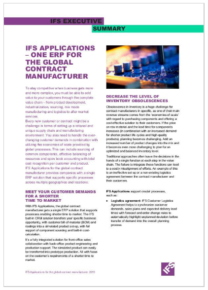Over the past few years, the highly unstable prices on raw material and the increased lead time from suppliers on components have put financial pressure on many manufacturers as they experience challenges to quickly respond to the market volatility. Of course, the overall planning of optimized inventory levels relies on accurate demand planning and forecasting, however in the world of contract manufacturers you rely on your customer to do the forecasting as accurately as possible. So how do you effectively set up your customer logistic agreements to handle change management and reduce the risk of inventory obsolescence?
Obsolescence in inventory is a huge challenge for contract manufacturers in specific as one of their main revenue streams comes from the ‘economies-of-scale’ with regards to purchasing components and offering a cost-effective solution to their customers. If the price of raw material and the lead time for components increases, in combination with an increased demand for shorter product life cycles and high-quality products – and add an increased number of product changes into the mix – it is challenging for the contract manufacturer to plan for an optimized and balanced inventory level.
Traditional approaches often leave the decisions in the hands of a single function at each step in the value chain. The failure to integrate these functions can lead to a costly misalignment of efforts, an example of this is an ineffective setup or a non-existing logistics agreement between the contract manufacturer and its customers.
Effectively set up your customer logistics agreement
Logistics management is an important component of the business operations of any company as it has a direct impact on a company’s bottom line and customer relations. So, it is important to ensure that your logistics agreement is set-up efficiently to manage the relationship between you and the customer. How to handle changes in demand or to the product? Who bears the responsibility for the prognosis and demand deviations and any obsolete inventory?
Forecast deviations in combination with long lead times on components drive inventory obsolescence. With an effective use and set-up of the logistics agreement you will get pro-active control on both short- and long-term demand changes before they will affect your inventory planning process.

Optimize your demand planning
Planning is key for the contract manufacturer to balance demands on customer delivery lead times and components purchase lead times, also considering the internal production capacity.
As the forecast often is a source of uncertainty and your accumulated critical lead-time increases you should also look for alternative planning solutions like Demand Driven MRP (DDMRP).
DDMRP can optimize your demand planning by the use of planning methods much more effective for today’s dynamic and volatile environment.
Simulate and analyze inventory obsolescences
The logistics agreement can play a dual role for the contract manufacturer, as it can help give them an overview on the number of deviations from the agreement and thus give a foundation for analyzing the source and reasons of inventory obsolescence. With your ERP solution, you should also be able to analyze your products bill-of-materials, down to a specific component in inventory to see which of your customers are the owner(s) and drivers of demand.

This inventory and component analysis will be the major baseline when you simulate for obsolescence probabilities for proactive handling with the affected customers and also when you have the final obsolete result to be discussed with affected customers.
Are you in the need of any advice around how to reduce your obsolete inventory? Please contact Mikael Hultin for a chat or download this executive summary to learn more.
Do you have questions or comments?
We’d love to hear them so please leave us a message below.
Follow us on social media for the latest blog posts, industry and IFS news!
Photo by Louis Reed on Unsplash
Walid Hammad
Excellent article…. thanks, Michael
Minor query, What exactly the difference(s) between DDMRP & Regular MRP as the planning engine should consider all the parameters in every use (for example, in my last implementation I recommended the client to run it twice a week).
Ellen Jaudon
Hi Walid, thanks for your response and sorry for my late reply.
Yes currently MRP is the main planning solution within the industry and still a method very dependent of demands (like forecasts) with high accuracy.
An alternative planning method is DDMRP which is more dynamic and not that dependent of demand accuracy.
DDMRP is a planning and execution method based on strategically placed decoupling point stock buffers,
it combines the aspects of Material Requirements Planning (MRP) and Distribution Requirements Planning (DRP)
with the pull and visibility emphases found in Lean and the Theory of Constraints.
Please check https://www.demanddrivenmrp.com for more information.
Shirley
Once the full costs of inventory have been measured and quantified, those costs can be evaluated and managed. And what becomes immediately apparent is not just the cost of the inventory that is essential to the business, but the cost of the inventory that is not essential, that is excess, dead or under performing, and what a financial drag this inventory is on the company.
Ellen Jaudon
Hi Shirley, thanks for your response.
Yes agree, a higher focus should be on the inventory cost driven by excess or dead inventory and how this affects the overall result for a company.
For a Contract Manufacturer type of business the complexity in such a analyze also includes the customer dimension,
as it is often the customer and incorrect demands on forecasts and customer call offs that drives this inventory excesses.
To handle this situation both with a planning perspective and business relation perspective,
ERP solutions (like IFS Applications) with focus on Contract Manufacturing is absolute key.
her
Hello there! I could have sworn I’ve been to this site before but after checking through some of the
post I realized it’s new to me. Anyways, I’m definitely glad
I found it and I’ll be bookmarking and checking back often!